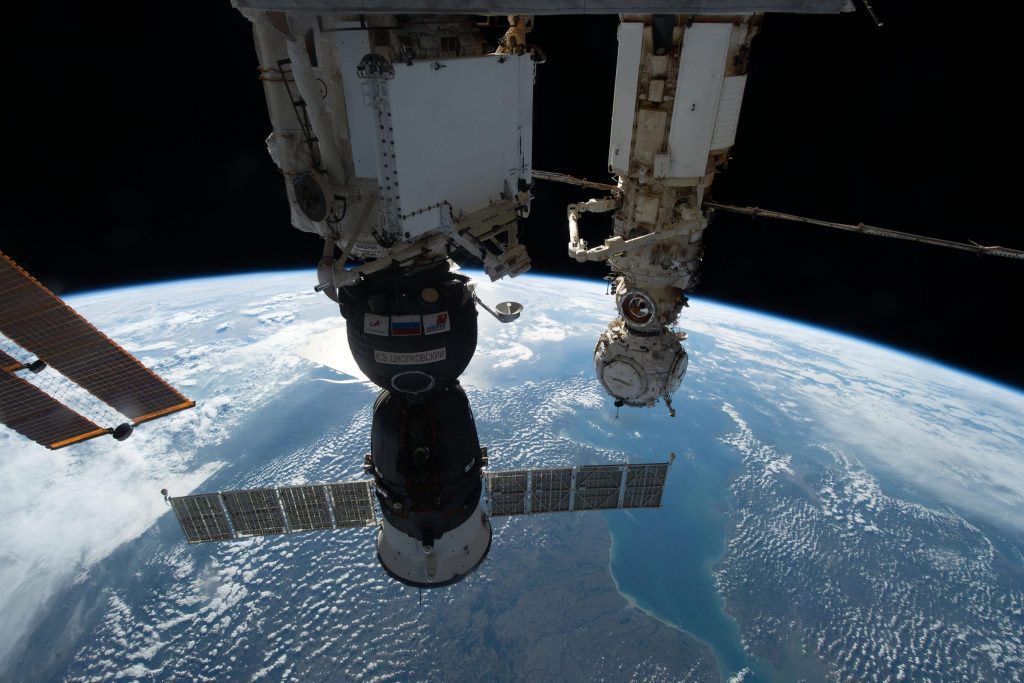
Foto kapal kru Soyuz MS-22 diambil di modul Rassvet. Di latar belakang, Modul Docking Prichal dilampirkan ke Modul Laboratorium Serbaguna Nauka. Kredit: NASA
external leak from the Roscosmos Soyuz MS-22 spacecraft docked to the Rassvet module of the International Space Station (ISS) that was detected on December 14. Roscosmos identified the source of the leak as the external cooling loop of the Soyuz spacecraft.
Roscosmos flight controllers conducted a successful test of the Soyuz MS-22 thrusters at 3:08 a.m. EST Friday, December 16, as part of the ongoing evaluation and investigation. The systems that were tested were nominal, and Roscosmos assessments of additional Soyuz systems continue. Temperatures and humidity within the Soyuz spacecraft, which remains docked to the Rassvet module, are within acceptable limits.
NASA is supporting the ongoing investigation with the use of the Canadarm2 robotic arm to provide additional viewing of the Soyuz exterior on Sunday, December 18. To accommodate this change in plans, NASA has postponed the upcoming U.S. spacewalk to install an International Space Station Roll-Out Solar Array (iROSA), which was originally scheduled for Monday, December 19. The new target date for the spacewalk is Wednesday, December 21.
The Soyuz MS-22 spacecraft carried NASA astronaut Frank Rubio and Roscosmos cosmonauts Sergey Prokopyev and Dmitri Petelin into space after launching from the Baikonur Cosmodrome in Kazakhstan on September 21.
The leak was first detected on December 14 at around 7:45 p.m. EST, when data pressure sensors in the cooling loop showed low readings. At that time, Roscosmos cosmonauts Sergey Prokopyev and Dmitri Petelin were preparing to conduct a spacewalk. The spacewalk was canceled, so the cosmonauts did not exit the space station or become exposed to the leaking coolant. From data analysis and cameras aboard the space station, the majority of fluid had leaked out by yesterday, December 15, around 1:30 p.m. EST.
More updates will be provided as data becomes available.
On station, the Expedition 68 crew members set up a variety of advanced research gear to capture high-definition video of Earth and house biology samples for observation.
Flight Engineers Josh Cassada and Frank Rubio reviewed spacewalk robotics activities with Flight Engineers Nicole Mann of NASA and Koichi Wakata of the Japan Aerospace Exploration Agency (JAXA).
Cassada and Wakata also had time on Friday morning configuring hardware supporting advanced space science experiments. Cassada assembled the SphereCam-1, a digital ultra-high resolution video camera, inside the U.S. Destiny laboratory module. He pointed the camera outside Destiny’s science window, or Window Observation Research Facility, and filmed Earth demonstrating its ability to capture the highest resolution, groundbreaking 12K views from a spacecraft. Wakata activated the Cell Biology Experiment Facility (CBEF) inside the Kibo laboratory module that will house scientific samples for future space biology research. The CBEF is an incubator that supports a variety of life science observing cells, plants, and small mammals.
Prokopyev and Petelin cleaned their Orlan spacesuits and stowed their spacewalking tools following the postponement of Wednesday night’s spacewalk.
Flight Engineer Anna Kikina also worked on post-spacewalk activities returning the station’s Russian segment to normal and checking radiation sensors worn on the Orlan suits. Kikina wrapped up her day treating surfaces inside the Zarya module with an anti-fungal agent to maintain cleanliness and health aboard the station.

“Penyelenggara amatir. Penginjil bir Wannabe. Penggemar web umum. Ninja internet bersertifikat. Pembaca yang rajin.”






More Stories
Makhluk yang menjadi fosil mungkin bisa menjelaskan gambar membingungkan di dinding batu
Gambar dramatis dari bulan panen raksasa dan gerhana bulan sebagian
SpaceX meluncurkan satelit Galileo Komisi Eropa dengan roket Falcon 9 dari Cape Canaveral – SpaceflightNow